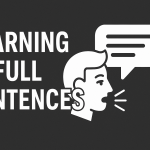In order to learn foreign language you need to memorize thousands of words and sentence patterns. There is just no other way. Memorization is fundamental to language learning. However, the method you will be using, the content and the timing of your learning will determine your success or failure.
We looked at the mechanisms of human memory and we integrated them into the Taalhammer app. We give you a ready recipe so you can effortlessly optimize your memorization and be successful.
In the first part of this article we talked about short term memory, how you create mental reflexes and how the spaced repetition algorithm works in taalhammer.
In this article we are going to focus on the best ways to create an unconscious knowledge of language, the importance of creating your own curriculum and how a healthy lifestyle can boost the way to store and recall information.
Three reasons Sentence Mining is the best way of learning foreign language
What is the best way to learn a language?
While memorising lists of words and grammar rules is one of the most common ways to learn a language, it is also one reason many people end up quitting. For most people, it’s grammar and vocabulary that is the most tedious part of learning a second language. It usually takes many hours of senseless repetition; there’s no fun in that and the results are mediocre at best.
So, what can we do to change this?
Well, there’s a far more effective technique that will keep you engaged and put you in contact with real-life language from day one: sentence mining. Sentence mining is the act of learning a new language by understanding sentences instead of isolated words.
This is why in Taalhammer you are predominantly learning with sentences.
Look at these examples:
- I go to the gym.
- She goes to the gym.
- She goes to the city.
- They do not go to the city.
Memorising such sentences has several advantages.
Most importantly, your brain is optimising the memorised data — it cuts them into fragments and identifies patterns. This is exactly the same process that took place in our neurons when we acquired our native language. You will be able to speak grammatically without consciously knowing the grammatical rule behind it.
Learning words in context is not only more memorable, but also it is more useful to learn how words are actually used. Seeing the same word or grammatical item in different contexts will help you innately absorb how it should be used in other sentences, as well.
Finally, you can expose yourself to how the language sounds and improve your pronunciation.
Learning foreign language with whole sentences can seem difficult at first. People often prefer learning vocabulary because it is simply easier.
However, language is all about sentences, and these sentences need to be memorised and practised. Say them out loud with every repetition! Each time you will be able to give the correct answer to more and more items.
How to Easily Create Your Own Curriculum with the Hammer Editor
The core collections in Taalhammer teach you the fundamentals of the language, but what if you want to invite someone for a date? Or buy flowers for your girlfriend?
In order to prepare yourself to talk about the things that are relevant specifically for you, you need to create your curriculum. In Taalhammer you can use the Hammer Editor to add your own content to the learning stream. Your own content carries a lot of emotional connections with the context and the situation it was created in. And research suggests that words and sentences that carry an emotional connection are remembered the fastest.
Have you found an interesting sentence on the web? Did you go to the flower shop and wanted to say “bouquet of roses” and did not know how? Or did you get stuck in a traffic jam, and were wondering how to say “traffic jam”? Own your own language learning process: paste all those phrases into the editor, use the automatic translation and save it to your own collection. Taalhammer will make sure you remember it forever.
Are you having online classes? Ask your teacher to add all the new words you are learning directly to Taalhammer. All your information will be stored in one place, directly available for learning on your desktop and mobile devices.
Finally, you can use the editor to build your individual memory associations — using our autosuggest functionality.
Start with a word you did not know, for example “kiss”. Type it in the editor and Taalhammer will suggest some example phrases and sentences.
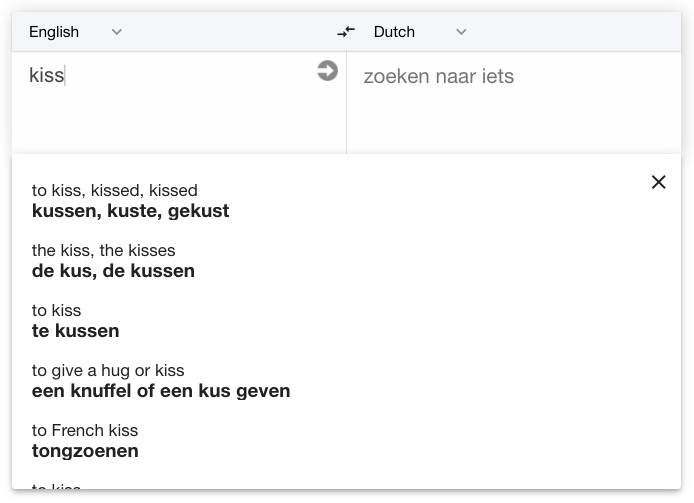
Choose, for example, “to give a hug or kiss” which is “een knuffel of een kus geven”. With one click you can save this sentences to your learning collection and Taalhammer will make sure you will never forget it.
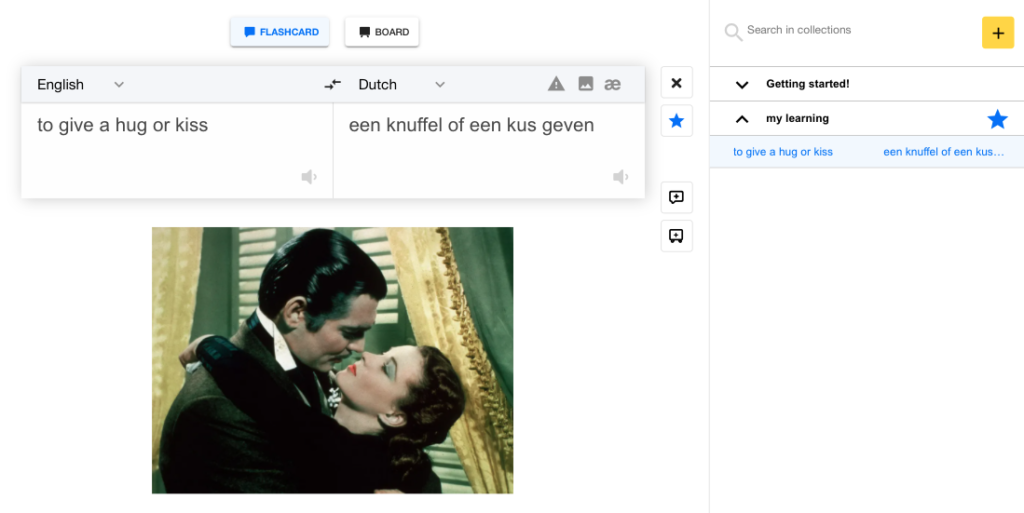
Now search in your target language for the word you did not know in the previous sentence, for example for “knuffel” (i.e. hug).
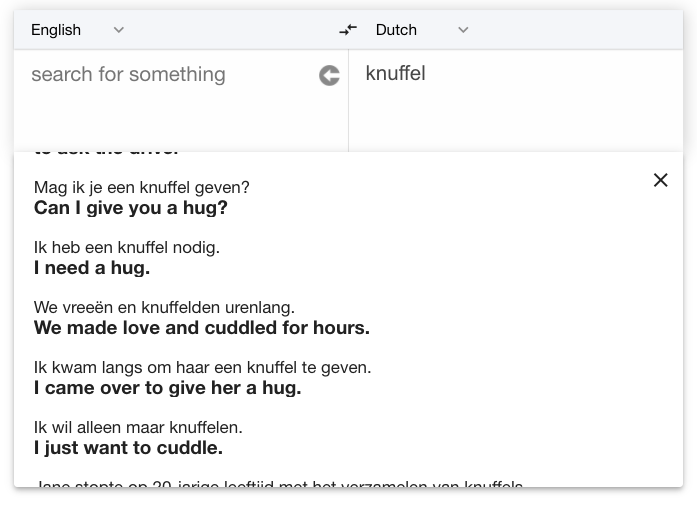
Choose a sentence you like and save it again, e.g. “We vreeën en knuffelden urenlang.” i.e “We made love and cuddled for hours.“.
And now again search for the English word you did not know e.g. “make love” etc. I hope you see the patters.
By doing that you are attaching the meaning of new words and sentences to previous ones. And because you are the one who makes the choices, your brain will remember this immediately.
Why is sleep so important for your memory
OK, maybe not immediately. Have you ever felt that you remembered things better after taking a nap or, even better, after a good night’s sleep? You are not alone.
Biologically our memory requires consolidation, and the consolidation happens when we sleep.
Of course we are not claiming that you can learn new things during your sleep. Actually attempts at learning during sleep should be discouraged. But you need to sleep well in order to make sure the things that you learn during the day are optimally remembered.
A good analogy is the gym again. Your muscles don’t grow in the gym; rather they grow when you are giving yourself a break. If you don’t have regular rest and recovery days, then you are actually hindering your bodybuilding process.
One of the most important functions of sleep is the reorganisation of neural networks in the brain.
We can compare the brain and its sleep cycles (which are REM i.e. Rapid Eye Movement and NREM) to a computer. During the day, while learning and experiencing new things, you store your new data in RAM memory, which is very fast but short term. After a long day, the brain is full of disorganised pieces of information that need to be integrated with things we have learned earlier in life.
During the night, while first in NREM, you write the data to the hard disk: the words and sentences are moved from your short-term memory to your long-term memory. During REM sleep, which follows NREM, you do the disk defragmentation, i.e. you organise data, sort it, build new connections, etc. Here your brain discovers the seemingly unrelated structures, so you can build grammatically correct sentences without conscious knowledge of rules.
Overnight, you repeat the write-and-defragment cycle until all RAM data is neatly written to the disk (for long-term use) and your RAM is clear and ready for a new day of learning. Upon waking up, you reboot the computer.
Respect sleep as your tool for high IQ and good learning.
Follow this simple pattern if you want to further hack your memory:
- study
- sleep
- study again.
How physical exercise helps in foreign language learning
When should you study?
You should study when your brain is at its maximum alertness. There are two quality alertness blocks during the day, both based on your circadian rhythm and sleep pressure. The first one is in the initial five hours after awakening and the second is after the siesta period, i.e. 9–13 hours into the day.
So how can you increase your alertness?
A number of recent studies have shown that working out during learning amplifies the ability to memorise and retain information. Weightlifting, cycling, walking, running, aerobics or any other physical effort alters the biology of the brain to make it more malleable to learning by increasing the flow of oxygen and the number of neurotransmitters in the brain.
This assists your ability to focus, concentrate, remember and handle stress.
Don’t push it too hard, though: vigorous workouts can raise your stress levels, which can impede your memory circuits.
How Does Listening Mode Work With Taalhammer
What and how can you revise while exercising?
Taalhammer offers a great listening exercise where you can listen to all the items you have previously learned. Our algorithm will arrange the items in such a way that the ones that you have problems remembering will be first. This is a completely hands-free activity and all you have to do is press PLAY.
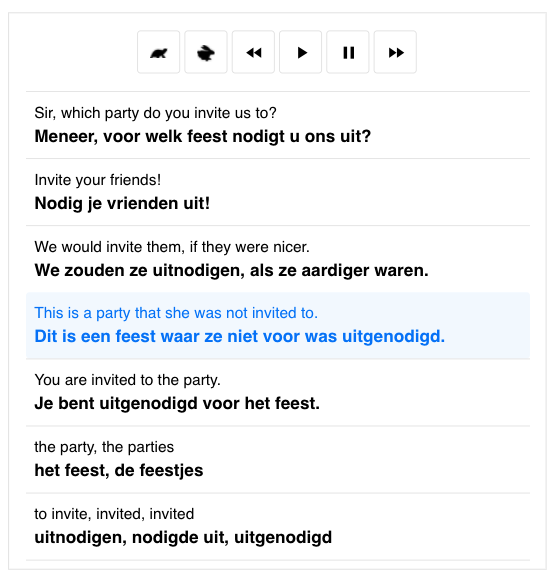
You will first hear the item in your source language. Then you have time to think about the translation in your target language. If you know the answer immediately, say it aloud. If you don’t know, make a real effort to scan your memory (to train your memory muscle). After a few seconds you will hear the translation, so you can verify if your answer is correct. Again, you’ll then have time to repeat the answer. And again, repeat it loud!
The whole sequence looks like this:
Source language – Pause – Target Language – Pause – Next Item.
This is similar to how you learned your first language — repeating sounds exactly as you hear them. It is the best way to hack your memory even more but to master the accent and intonation as well.
Enjoy hacking your memory with Taalhammer — Language Learning that Works.






